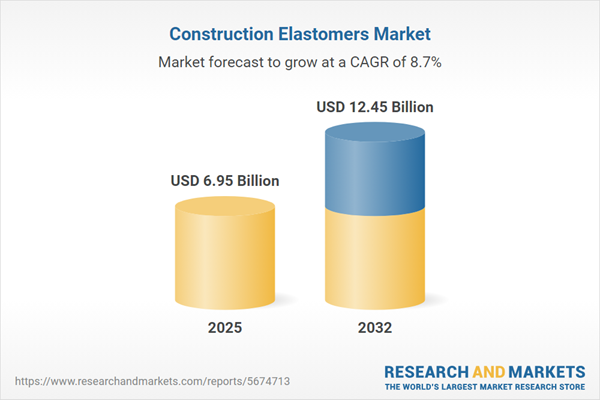Speak directly to the analyst to clarify any post sales queries you may have.
As senior decision-makers navigate the evolving construction elastomers market, increased regulatory complexity and changing project demands require a deliberate approach to material selection. This report offers focused guidance to support informed procurement and sustainable construction strategies across today’s dynamic landscape.
Market Snapshot: Construction Elastomers Market – Primary Growth Drivers
The construction elastomers market is demonstrating robust growth, underpinned by large-scale infrastructure investments and ongoing changes in regulatory frameworks prioritizing advanced building materials. High-performance elastomers are integral to civil, commercial, and architectural projects, valued for their durability, flexibility, and extended service life. Market dynamics are shifting as manufacturers enhance formulation standards and the sector pursues increased adoption of sustainable elastomeric materials. Demand is rising for operational resilience and innovative construction solutions, accelerating elastomer usage in both new builds and refurbishment projects.
Scope & Segmentation of the Construction Elastomers Market
- Elastomer Types: Includes natural rubber and engineered synthetic polymers such as chloroprene, ethylene propylene diene monomer, nitrile, and styrene-butadiene. Each type is tailored to deliver specific characteristics for performance, resistance to wear, and longevity in demanding construction contexts.
- Applications: Encompasses adhesives, anti-corrosion coatings, gaskets, seals, expansion joints, waterproofing membranes, pond liners, and roofing solutions. These applications safeguard construction assets from the initial design phase through ongoing maintenance cycles.
- End-User Industries: Spans commercial, residential, and industrial development, along with sectors such as energy, transportation, and water infrastructure. Elastomers support compliance with advanced standards and contribute to improved, consistent project quality.
- Distribution Channels: Incorporates direct sales by manufacturers, broad distributor networks, and expanding e-commerce models. This diversity enables organizations to align procurement methods with project schedules and unique requirements.
- Regional Dynamics: The Americas and Europe emphasize established quality benchmarks and material innovation, whereas Asia-Pacific, Africa, and the Middle East prioritize compliance with local building codes and specialized applications.
- Company Landscape: Features established industry participants, including BASF SE, Huntsman Corporation, Wacker Chemie AG, Arkema S.A., Mitsubishi Chemical Advanced Materials AG, RTP Company, Saint-Gobain Group, DuPont de Nemours, Inc., The Dow Chemical Company, Covestro AG, and Celanese Corporation. Ongoing product development and portfolio expansion fortify market presence and stability.
Key Takeaways for Senior Decision-Makers
- Increasing integration of bio-based and recycled elastomers positions organizations to better anticipate new environmental requirements and adapt their sustainability initiatives accordingly.
- Advancements in nanotechnology enhance the performance of elastomeric materials, leading to improved resistance and reduced long-term maintenance needs for critical infrastructure.
- Adapting to diverse regional regulations and project-specific codes requires targeted expertise, ensuring alignment with operational, environmental, and safety objectives across global projects.
- Digital procurement platforms and streamlined direct purchase strategies give buyers greater agility and control, allowing for faster, cost-effective elastomer acquisition tailored to varied projects.
- Collaboration between material scientists, suppliers, and construction teams supports the successful deployment of high-performance elastomers in public and private sector developments.
- Strategic diversification in sourcing and broad, adaptable portfolios reduces organizational exposure to shifting compliance rules and supply chain uncertainty.
Tariff Impact on Supply and Procurement
Recent tariff measures in the United States on raw materials from Southeast Asia and Europe have led manufacturers to diversify supply networks and boost local production capacity. These adaptive strategies safeguard the supply chain, ensuring material availability and managing the risks associated with price volatility or cross-border logistics constraints.
Methodology & Data Sources
This report leverages a comprehensive methodology, integrating perspectives from executive and technical expert interviews, procurement professional input, regulatory guideline analysis, and direct site observations. Together, these sources underpin an objective and practical knowledge base for procurement teams and project strategists in the construction elastomers market.
Why This Report Matters for Construction Elastomers Market Stakeholders
- Enables operational and sourcing teams to adapt quickly to regulatory changes and supply chain fluctuations, minimizing project risk.
- Equips senior leadership to address evolving market and material requirements proactively, supporting project success and resilience.
- Facilitates adoption of innovative procurement and technology strategies, enhancing competitive positioning across multiple markets.
Conclusion
This report distills actionable insights to help decision-makers meet evolving construction challenges, streamline procurement, and support sustainable results in both greenfield projects and infrastructure upgrades.
Additional Product Information:
- Purchase of this report includes 1 year online access with quarterly updates.
- This report can be updated on request. Please contact our Customer Experience team using the Ask a Question widget on our website.
Table of Contents
3. Executive Summary
4. Market Overview
7. Cumulative Impact of Artificial Intelligence 2025
Companies Mentioned
The companies profiled in this Construction Elastomers market report include:- BASF SE
- Huntsman Corporation
- Wacker Chemie AG
- Arkema S.A.
- MITSUBISHI CHEMICAL ADVANCED MATERIALS AG
- RTP Company
- Saint-Gobain Group
- DuPont de Nemours, Inc.
- The Dow Chemical Company
- Covestro AG
- Celanese Corporation
Table Information
| Report Attribute | Details |
|---|---|
| No. of Pages | 184 |
| Published | November 2025 |
| Forecast Period | 2025 - 2032 |
| Estimated Market Value ( USD | $ 6.95 Billion |
| Forecasted Market Value ( USD | $ 12.45 Billion |
| Compound Annual Growth Rate | 8.6% |
| Regions Covered | Global |
| No. of Companies Mentioned | 12 |









